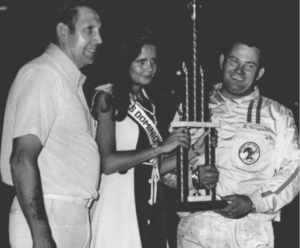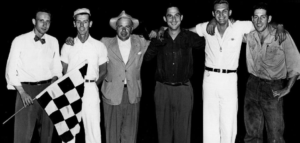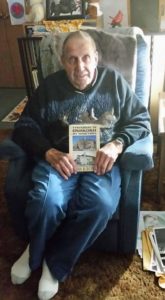The Vault
LEO’S SPEEDWAY – THE PLACE TO BE IN OSHKOSH ON TUESDAY NIGHTS
Posted on: Thursday December 2, 2021
(The following is a chapter pulled from the 2015 release “Life In The Past Lane – a history of stock car racing in northeast Wisconsin from 1950-1980.” This book along with Verdegan’s other titles are all for sale at this website by clicking on the “books” tab in the upper left corner)

Leo Galica (left) poses with a trophy girl and Dave Conger after Conger scored a win at Leo’s Speedway. Galica promoted races at third-mile, clay oval until the track closed in 1978. (Leo Galica photo collection)
Oshkosh’s Leo Galica got to see short track racing from both sides of the fence.
Galica, who promoted Leo’s Speedway at the Winnebago County Fairgrounds from 1961 thru 1978, got his start as a 20 –year-old driver at what was called Oshkosh Raceway in 1950. “I had an old Ford coupe that we basically stripped down bare bones and went racing with it,” recalled Galica. “We didn’t really do anything to it at all. We didn’t even have $100 invested in the car. We turned it into a race car at Barney’s Wrecker Service just down the road from the track. When we started the track was in its first year in 1950. There weren’t many locals out there initially so it was a lot of guys from the Milwaukee area who raced at tracks in Cedarburg and Hales Corners, and Plymouth too. Harry Danforth was the first promoter there. He was from Milwaukee and he leased the quarter-mile track from the Winnebago County Fair Association just like I did years later.”
Galica sported the car number 6 and 7/8. “One of my crew guys picked the number,” recalled Galica. “It had something to do with a cartoon in the funny papers back then. I don’t recall specifically why. Lee Roy Beyer was one of my crew guys. He moved to Chicago and went on to be a cop down there.” It took a few years but by 1953 a stronger base of Oshkosh area teams had evolved and began to give the hot dogs from the other tracks a run for their money.
One of the earmarks of Oshkosh racing history that from day one, up until the track closed in 1978, the weekly races were run on Tuesday nights, for several reasons. “The other tracks all ran other nights so they were taken,” said Galica. “When Oshkosh started there weren’t hardly any tracks north of Oshkosh, but in time when Apple Creek and Kaukauna got running we’d draw those guys too. It wound up being a real melting pot with the north and south guys running together on Tuesday nights. We were the only game in town so to speak and Tuesday nights worked well for us.”
In the 1950’s several different promoters took turns operating the track at Oshkosh, including Eddie Lee, Dick Burton from Green Bay and John Marquis, who had promoted races at both De Pere and Luxemburg.
When the track first opened, the p.a. announcer was none other than Al Sampson. Sampson would later go on to become a sportscaster at WLUK TV 11, and one of the pioneers of covering outdoor hunting and fishing events on local television. “Al Sampson got his start as an announcer at Oshkosh and not a lot of people probably even know that,” said Galica. “But he did. And he was a good announcer, too.”

A little known fact is longtime WLUK TV 11 sportscaster Al Sampson (far left in the photo) got his start into broadcasting by handling the p.a. duties for Leo Galica at the Oshkosh race track. (Leo Galica photo collection)
When Galica took over the reins of the program in 1961 he tried running both Tuesday nights with the coupes and an additional Friday night with the modifieds from the Plymouth and Milwaukee area. “We’d get the guys like Miles Melius and the bunch and it worked for a while,” Galica said. “But after a while it died out and we just stuck to Tuesday nights and that worked well for us.”
In addition to Melius, some of the other stars of that era included Appleton’s Glen Bessette, Two Rivers Bucky Wagner, Plymouth’s Bob Wester and Porky Holschuh.
While running the track Galica also managed the Winnebago County Fair and worked at Rockwell Corporation in town. Balancing his personal life and running the race track was often a very delicate task. “My wife did all the book work and there were times I’d be out until 1 a.m. watering the track,” said Galica. “You had to water it at night to keep the moisture in it. We didn’t need or want any dust. It was a lot of work.”
Galica was a hands on promoter who handled many aspects of the racing program, including advertising and public relations. “I handled all that stuff and get results in the Oshkosh Northwestern and on radio on WOSH,” said Galica. “Honestly we didn’t have to advertise a whole lot locally because we had a pretty good product. They’d get our results in the media and that worked.” In the later years local photographer Dave Panske would write up stories recapping the racing for Checkered Flag Racing News.
Like most other tracks in that era, safety wasn’t a big concern. The cars that competed at Oshkosh were crudely built. “All the guys had was a roll bar welded in behind the seats,” said Galica. “All they had was a lap belt too. There was no shoulder harness or anything like that. Drivers knew what they were getting into.”
Tragedy struck in the mid 1960’s when Vic Sergio, a driver from the Redgranite area, was killed. “Somebody lost a tire on the track. Somebody yelled “loose wheel!” Vic stood up to see and that’s when the tire hit him. He was hooking up lights to his car and he was getting ready to pull out. ” Bobby Madden of Oshkosh was killed in a demolition derby race at the track years later.
Galica paid drivers 45 percent of the front gate receipts. “Crowds were good so the drivers got paid well,” said Galica. “I remember Dave Conger told me right before he died that he made some real good money racing by us. I’d pay as much to get fast time as I did a feature win. Time trials were a pretty big deal back then.”
In the mid 1960’s the Fox Valley Stock Car Association sanctioned the races at Oshkosh and Galica became more of a landlord-type then a promoter. “The Association handled all the payout to the drivers and they enforced all the rules back then,” said Galica. “Orv Koury was the President. He was the point man on that. Basically they’d deal with any driver-related issues and I worried about the front end on race nights.”
Crowds were near capacity some nights. “I remember that grandstand, with bleachers held 5,000 people,” said Galica. “I remember some nights the purse was $4,400 so I knew we had 5,000 people in the stands. Those Tuesday nights really helped keep the stands full.”

Leo Galica during his interview in 2015 with author Joe Verdegan for the book “Life In The Past Lane – a history of stock car racing in northeast Wisconsin from 1950-1980.” (Joe Verdegan photo)
With the county fairgrounds being right in the city limits, some people would actually take the city bus to the races. “I’m pretty sure there aren’t too many race tracks around that can claim that,” joked Galica. “It was a real family affair. All the top drivers like the Congers and the Kleinschmidts – they’d have their groups sitting in the stands. Those guys brought people in the stands. And after the races they’d go across the street to Leon’s for ice cream.”
“The mix between Milwaukee and Northeastern Wisconsin cars was huge at that time,” said Oshkosh’s Bob Schafer, a longtime race fan. “From the late 1960’s to the demise in 1978 there was quite a variety of drivers at the track which you could not see anywhere else. Plus, outside of the Door/Kewaunee County circuit Oshkosh was the only smaller, non-half mile oval running in the early to mid 1970’s.”
“Roger Regeth was absolutely hated at Oshkosh,” said Schafer. “But that was good for Leo. The crowd loved the Oshkosh guys like Conger and Kleinschmidts. But it was Regeth and JJ (Smith) who really put people in the stands.”
Regeth was hated with almost a venom by Oshkosh fans, but “The Bear” took it all in stride. “I recall one night under the grandstands when the drivers were waiting for payout a woman went up and asked Roger for his autograph,” said Jeff Lemiesz of Oshkosh. Lemiesz is part of a promotional team that promoted races at the new Oshkosh Speedzone beginning in 2001. “Regeth signed the picture. She took the picture, threw it at him and told him to wipe his ass with it. Roger just took it and thanked the woman.”
“By me at Oshkosh they called Regeth’s car the Sherman tank because it basically was indestructible,” said Galica. “He had a real good rivalry with (Dave) Conger. Conger got more cheers because he was the local guy.”
Other guys who ran well at Leo’s, according to Galica, were Wally Jors of Fond Du Lac and Menasha’s George Giesen. Jors died of a heart attack while racing at Hales Corners Speedway in 1976. “Wally and George were both great guys,” said Galica. “I’d go visit Wally on occasion for a while at his place in Fond Du Lac and George ran that USAC deal for quite a while. Giesen always had purple race cars. Terry Baldry got his start by us too. His parents were great sponsors of the track for many years.”
According to Schafer, who kept detailed statistics throughout the 1960s until the track closed in 1978 Regeth was the winningest driver, copping 18 feature wins. Hometown driver Dave Conger nabbed 13 while JJ Smith won 10. Jors, Appleton’s Bob Schroeder each scored eight feature wins while Wagner won seven times. “Basically in the 32 years history of the track those six guys accounted for at least 15 percent of the feature wins at Oshkosh,” said Schafer, who’s attended races at 520 tracks in the United States. One year Schafer hit 334 races in one season, traveling across the country.
For all the years Galica promoted Leo’s Speedway he dealt with the Winnebago County Fair Association, which had a 25 year lease with Winnebago County to lease the Fairgrounds. When that lease expired in the late 1970’s, Galica could see the writing on the wall. “They were looking for reasons to get rid of racing by us because they wanted to sell the fairgrounds and move it to another location,” said Galica. “They deemed the grandstand unsafe for use. That was the beginning of the end for me.”
To compound the grandstand issue, some area residents filed noise complaints with the city during the last couple of years the track was open. “I even remember Glen Lloyd from TV 11 coming down to a story on it towards the end,” said Galica. “He stood outside the track while the races were going with his decibel meter or whatever he had. We had a decibel limit that the cars had to be. I remember semis driving by were louder than race cars. Nothing ever came of it though.”
Still the good times outnumbered the bad when Galica looks back. “I remember the fans would be lined up at 4 o’ clock in the afternoon, waiting to get in and put their blankets down in the grandstands to save their seats,” said Galica. “We used to have cherry pie races for the drivers. They’d have to eat a cherry pie and then take a lap. It was a big hit with the fans and drivers alike.
The last race Leo promoted at Oshkosh was July 12, 1978. West Allis’ Bill Strom would wind up being the final late model champion in the history of Leo’s Speedway. The fairgrounds was relocated close to the highway on the north end of town many years later where racing, despite some local pressure, would return to Oshkosh in 2001.
Galica was inducted into the Oshkosh Speedzone Hall of Fame in 2008.


